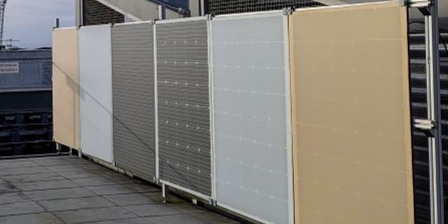Researchers from Swiss and Austrian institutions have demonstrated a new design for a glass-free, structurally robust silicon PV module. With a weight below 6 kg/m2, the intended application is older buildings with a weak roof structure.
To make silicon PV panels better suited for building integrated PV (BIPV) applications, such as low tax -bearing facades, as well as roofs of older buildings and warehouses, researchers based in Switzerland and Austria built new glass -free modules. The target weight was less than 6 kg/m2 and the mechanical and environmental robustness was the focus of testing.
“The research was motivated by the urgent need for lightweight, visually attractive and structurally robust photovoltaic modules that are suitable for building integration, especially for retrophilic PV Magazine.
The design contained a backheet component made of a polypropylene honeycomb core between fiber optic reinforced composite skins in a sandwich structure, of which Desai remarked was “promising” because of the mechanical stiffness and low weight. In addition, Polymere Frontsheets were examined as “alternatives to glass to reduce the weight”, while retaining optical performance. In addition, encapsulated colored foil was integrated into some of the modules.
“This combination was aimed at both the mechanical reliability and the aesthetic requirements of the BIPV market,” Desai explained.
The panel components were as follows: a composite rear leaf consisting of fiberglass-reinforced polymer (GFRP) skin, polymer honeycomb, GFRP skin, commercially available polyolefin elastomer (POE) Incaping Inkapsels Without UV-Additieven, Cellen-Size, and Cello-Size, and Celacia-Facial-Facial-Facial-Facial-Facial-Facial-Facial-Facial-Facial-Facial-Comitter-Facial-Facial-Facial-Facial-Comitter-Facial-Facial-Facial-Facial-Facial-Row-Row-Row-Row-Row-Row-Row-Row-Row-Row-Row-Row-Size Encapsulant, Encapsulant, Encapsulant, Encapsulant, Encapsulant, Encapsulant, Encapsulant, Encapsulant.
The researchers evaluated two polypropylene skin variants with fiber densities of 820 and 660 g/m2, with the high fiber density that shows greater stiffness. Other mechanical and environmental aging tests, such as 2,000 hours of moisture heat, 400 thermal cycles, 60 kWh/m2 UV-exposure and 40 moisture-freezing cycles, were completed in parallel, resulting in less than 5% power loss.
“The low relegation under harsh aging of the environment, larger than IEC 61215: 2021 conditions, exceeding conservative expectations,” co-corresponding author, Antonin Faes, said told PV Magazine.
Greeting impact and fire inflammation tests were also performed. “Although the impact of 25 mm hailstones was survived, Brandtests revealed that the honeycomb core showed damage under the exposure to flames, but could be classified to pass class E of the ISO 11925 fire standard,” Desai said.
Regarding the impact of the colored films on the performance of the Perc module, the module efficiency without color was 19.4%, which fell to 14.28% for the dark gray color and 11.92% for the beige color.
Further modulet tests and related work are planned. ‘We are currently following the performance of these modules in the form of a facade to understand their performance in the actual outdoor operation in the Central -European climate, “Faes said.
The research team included members of École Polytechnique Fédérale de Lausanne (EPFL), Center Suisse d’Ell Electronique et de Microtechnique (CSEM), Österreichisches Forschungsinstitut für Chemie Und Technik (OFI), and MontanTitut.
Desai noted that a poster on the subject, “facade application of lightweight glass-free colored PV modules: reliability tests of the large format modules and monitoring of the demonstration place” will be presented on EU PVSEC 2025.
The team presented the module design and test results in “New mechanically robust and environmentally stable lightweight colored photovoltaic modules based on composite polymer-back shoes“Recently published in Solar RRL.
This content is protected by copyright and may not be reused. If you want to work with us and reuse part of our content, please contact: editors@pv-magazine.com.

